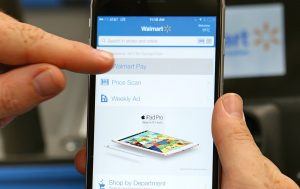The Supply Side: Omnichannel proficiency still lacking in retail, demand remains
by August 8, 2017 12:04 pm 491 views

Wal-Mart Stores and other retailers have spent billions trying to gain omnichannel proficiency in the past three years, but few retailers have attained proficiency, according to a recent study conducted by iQmetrix in partnership with RetailWire.
“Retail stores are at an inflection point and omnichannel proficiency is a priority as many retailers have dedicated teams working in this area,” said Tara Bartlett, director of marketing at iQmetrix, during a recent webinar on the topic.
Omnichannel is defined as providing a seamless shopping experience for the customer whether using their smartphone, desktop or purchasing in store. For instance, a shopper may go to the store and then see an item that is only available online in the color they want. They can use their smartphone or perhaps an in-store kiosk to order the product online and have it shipped to their home. Or in the case of Wal-Mart, customers get a discount if they choose to pick it up in the store.
Bartlett said omnichannel raises questions for suppliers, retailers and consumers. One main question is how does omnichannel change the role of the physical store? And also how will retailers successfully integrate digital and physical selling channels?
“The store has been central to the core shopping experience for decades, and that will continue, albeit in some different roles,” Bartlett said.
The study found 56.3% of the retailers surveyed said omnichannel efficiency is essential to their future. Another 28% said it’s a high priority, and 9.4% gave it a medium priority status. Just 3% of retailers responding to the survey said omnichannel is not a priority.
Bartlett said retailers are feeling the urgency of omnichannel faster than retail suppliers and service providers. The pressure is coming directly from consumers because of the choices they now have. Omnichannel does require investment by retailers to enhance and refine their in-store experiences. More than 83% of those surveyed see this as extremely or very important, 12.4% said it’s moderately important and just 1.2% said it is not necessary.

WAL-MART INVESTMENTS
Wal-Mart has invested in all three of those and more. More than $2 billion has been spent on higher wages and training for store employees over the past two years. The retailer also opted to remodel more stores this year while new store counts are lower.
Wal-Mart also has offered its own mobile pay option in stores that saves time at the checkout. The retailer also has ushered in an easy re-order button for its online grocery business which is picked up in stores. By scanning an in-store shopping receipt into Walmart’s Savings Catcher function in the app, the retailer has a record of that customer’s in-store purchases as well as online purchases.
With this data, Wal-Mart can curate a shopping list for the customer which shows up when they log into Walmart.com. To fill the complete order they just hit one button, or they can delete the items they don’t need and make changes to the curated list.
Wal-Mart U.S. eCommerce CEO Marc Lore has said the easy reorder has helped to shorten the time it takes for customers to complete their online shopping grocery lists. Likewise, he said investments in improving supply chains for Jet.com and Walmart.com allowed the retailer to offer pickup discounts for general merchandise when that option is chosen for online orders. Lore said the easy re-order button and the pickup discounts were each responsible for the retailer’s 63% jump in online sales during the first quarter ending April 30.

While Wal-Mart continues to invest in omnichannel proficiency, the retailer did not rank among the most proficient in the recent poll conducted during the webinar. The retail giant garnered just 2% of the vote by those polled.
IMPROVEMENT NEEDED
The recent survey found some of the investment priorities for retailers involve integration of inventory and order management across all channels as well as being able to deliver a consistent customer experience.
Bartlett said retailers that achieve the greatest success will be those who realign their organizations to be channel agnostic. She advocates shared platforms for all the channels of commerce, point of sales data, call centers and social media. She said silos must be broken down for retailers to fully achieve proficiency.
The survey also indicated areas that need the most improvement. They include:
• (71%) Improving and offering in-store pickup capabilities;
• (65%) Acceptance of online order returns in-stores;
• (63%) Visibility of product inventory at nearby locations; and
• (55%) Ability to order online from kiosks in stores or on a device.
Retailers taking part in the survey pointed to in-store pickup as the most important investment.
“Stores are becoming more like a fulfillment center,” Bartlett said. “The in-store pickup still trumps home delivery in the U.S., but it’s unknown how long that may be the case with Amazon Prime Now growing to more cities and Wal-Mart testing home delivery by using their own employees.”
She said innovations like easy mobile shopping apps, seamless pay and convenient pick up experience has connected to pull off a true omnichannel experience.
CHALLENGES AND WINNERS
During the recent webinar, Bartlett was joined by retail strategist Lee Peterson of WD Partners and Chuck Palmer of Consumer Retail. They discussed the challenges of omnichannel and their pick of the winners to date in the effort.
Peterson said stores today have to serve two distinct roles, one being an online fulfillment center and a social playground with a great experience that keeps customers returning. He said desired products, consistently good service and technology integrations in the store are a must to fully become efficient at omnichannel.
When asked which retailer he thinks has achieved the great success to date at omnichannel, Peterson said Starbucks has figured out how to use technology to allow consumers to order online and reduce their wait time. Starbucks also does a really good job with customization, Peterson said, keeping track of customer orders and sending specials and other marketing data.
He said Nordstrom’s test of Prey of Shoes in six cities allows customers to design their shoes which are made via 3D printing. He said Converse has a similar service in Los Angeles and Levi’s in San Francisco. He said the retailers have conquered the customization aspect and are delivering an experience consumers expect.
“Nobody really wants to shop on a loading dock. We are at an inflection point, and we have to think differently,” Palmer said.
He said the online order pickup role of the store needs to be approached in a creative way because a survey his firm recently conducted overwhelmingly found that customers ordering online didn’t want to come into a store to pick up the order.
Palmer said cosmetic company Sephora is his top pick for achieving proficiency at omnichannel. Bartlett agreed, saying Sephora is “killing it when it comes to omnichannel proficiency.”
“Personalization and the marketing they do in sending custom offers and tracking what you look at on their website and sending you a personalized offer on those items is very impressive,” Bartlett said.
–––––––––––––––––––––
Editor’s note: The Supply Side section of Talk Business & Politics focuses on the companies, organizations, issues and individuals engaged in providing products and services to retailers. The Supply Side is managed by Talk Business & Politics and sponsored by Propak Logistics.
